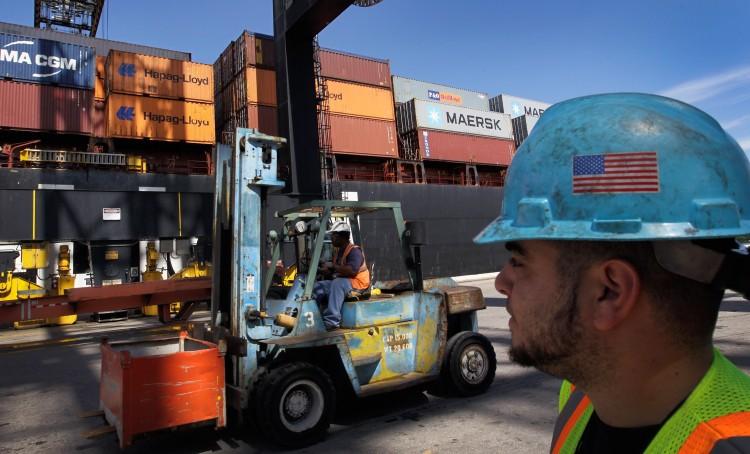Dockworker strike, cybersecurity, Panama Canal levels, Red Sea attacks, tariffs, hurricanes, infrastructure, and workforce woes stress $5.1 trillion sea trade.
Container cargo volume at the United States’ 361 commercial ports will grow by a modest 2 percent in 2025, a significant decline from 2024’s projected 9 percent increase, according to a November financial forecast by Moody’s Ratings.
Slowing economic growth and weakening consumer spending are among the primary factors influencing the flat projection, although Moody’s notes that its forecasted 2 percent increase is regarded as stable, while “a positive outlook would be considered if volume growth were to exceed 3 percent” in 2025.
Moody’s said its estimated 9 percent 2024 boost was buoyed by an 11 percent increase in shipping activity over the first eight months of the year, largely a result of retailers restocking inventories after the 2020–2021 COVID-19 pandemic disrupted manufacturing.
Non-economic issues that could skew 2025 projections for U.S. ports and maritime industries include a looming Jan. 15 longshoremen strike, cybersecurity concerns, hurricanes, water levels in the Panama Canal, shipping attacks by Houthis in the Red Sea, and President-elect Donald Trump’s potential tariff levies.
“The incoming president’s proposed tariffs, which could range from 10 percent to 60 percent on imports, might reduce trade and lead to a decline in cargo volumes, particularly affecting ports reliant on high trade volumes,” Moody’s states.
U.S. ports face growing infrastructure issues, as illustrated by the March crash of a Singaporean cargo carrier in an allision that destroyed Baltimore’s Francis Scott Key Bridge. Few U.S. ports can accommodate the Panamax and other larger-sized container ships that are increasingly dominating ocean trade.
The incoming Trump administration and Congress, after it is sworn in on Jan. 3, face pressures from port authorities to further increase spending on expanding and improving U.S. ports beyond allocations earmarked in 2021’s Bipartisan Infrastructure Law (BIL) and 2022’s Inflation Reduction Act (IRA).
Rebuilding the nation’s atrophied maritime industry and merchant marine is a long-term endeavor vital to national security and will require a significant investment in developing a skilled workforce to operate ports and merchant ships. The average wage of a port and maritime employee is almost $100,000, which is 20 percent more than that of the average U.S. worker, AAPA notes.

Longshoremen work next to a container ship at Port Everglades in Fort Lauderdale, Fla., in October 2011. Joe Raedle/Getty Images
1st Test: Jan. 15 Dockworker Strike
High-value labor presents the most pressing issue facing the nation’s ports. The International Longshoremen’s Association (ILA) and the U.S. Maritime Alliance (USMX), which represents shipping lines and terminal operators, are locked in a contract standoff. A strike could cost the U.S. economy between $5 billion and $7 billion a week within a month.
A temporary Oct. 3 agreement that ended a three-day work stoppage by 47,000 ILA dockworkers, paralyzing 36 ports from Portland, Maine, to Brownsville, Texas, expires on Jan. 15.
The October agreement between the ILA and USMX resolved several matters of contention—including a 62 percent wage increase over six years—but negotiations over automation have been stymied, and neither side appears willing to resume talks.
The ILA represents workers in 36 Atlantic and Gulf Coast ports, while the International Longshore and Warehouse Union (ILWU) represents dockworkers in 29 West Coast ports. In June 2023, the ILWU and the Pacific Maritime Association agreed to a six-year contract that included a $4.62 hourly raise in the first year and $2 hourly raises each year after.
There have been “no new developments” in contract talks, the advisory notes. “We strongly encourage our customers to pick up their laden containers and return empty containers at U.S. East and Gulf Coast ports before January 15.
“This proactive measure will help mitigate any potential disruptions at the terminals.”
The ILA maintains that USMX won’t budge on what it terms “semi-automated cranes” that the labor union maintains are near-fully automated and pose cybersecurity risks, whereas port operators argue the high-tech cranes enhance safety, efficiency, and port capacity.
Trump, whose second inauguration is set for Jan. 20, appears to be backing the dockworkers after meeting with ILA President Harold Daggett and Vice President Dennis Daggett at Mar-a-Lago in Florida on Dec. 12.
“The amount of money saved is nowhere near the distress, hurt, and harm it causes for American workers–in this case, our longshoremen.”
Original News Source Link – Epoch Times
Running For Office? Conservative Campaign Consulting – Election Day Strategies!


